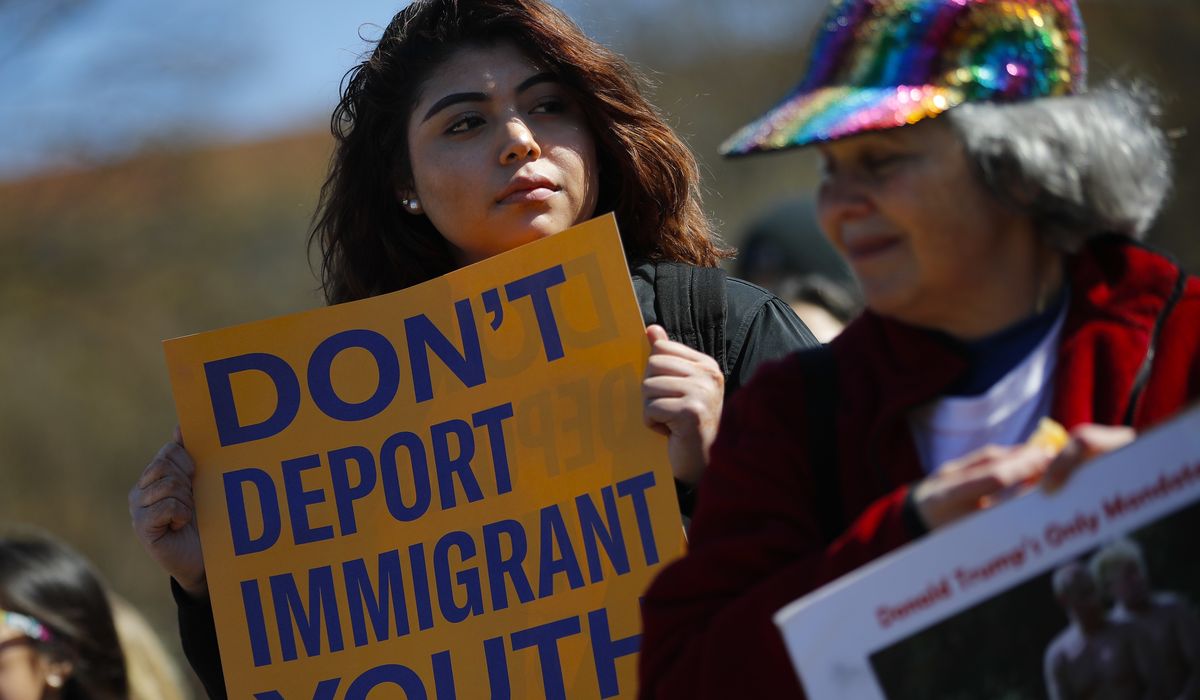
Any Immigration and Customs Enforcement officer who wants to arrest an illegal immigrant in the District of Columbia will have to hope the target is sunning in Rock Creek Park or rowing on the Anacostia River.
Those are some of the few places in the city not affected by Homeland Security Secretary Alejandro Mayorkas‘ new rules discouraging immigration enforcement near sensitive locations.
Schools and hospitals have long been no-go zones, but Mr. Mayorkas added food banks, homeless shelters, child advocacy groups, community-based organizations, school bus stops, day care centers and any other place where children might congregate. He said enforcing the law “near” those locations is virtually barred.
Mr. Mayorkas said people, including illegal immigrants, deserve to access services unfettered, so anywhere they get them should be considered off-limits except in exceptional circumstances.
The Washington Times took a map of the District of Columbia and plotted a fraction of off-limits locations — schools, day care centers, clinics, playgrounds, community centers, some churches, and some social services locations — figuring a 500-foot radius, or about half a city block, as the no-go zone.
The result is a city of sanctuaries.
Immigrant-heavy areas such as Mount Pleasant and Columbia Heights, and the Georgia Avenue corridor through Petworth and Brightwood, are saturated with protected areas. Capitol Hill, downtown Washington and much of the city south of the Anacostia River also are crammed with no-go zones.
Even wide-open spaces, such as Rock Creek Park and the National Arboretum, which don’t show up as protected on The Times’ map, could arguably be considered off-limits if an ICE supervisor deems them to be places where children might congregate.
There is nothing special about the District. ICE officers say you could draw the same map in just about every major U.S. city, effectively shrinking the space immigration agents have to operate under the Biden administration.
The rules apply not only to arrests but also to other “enforcement” actions such as tracking a target or conducting surveillance on a home or worksite.
One ICE officer pointed out that many of the agency’s office locations are in or near buildings that house day care centers. Taking the new rules literally could mean they aren’t supposed to be doing enforcement at their desks.
That officer called the rules “a trap.”
Chris Crane, president of the National ICE Council, said the list is so poorly written that it seems “intentionally written to foil law enforcement.”
“This is self-sabotage,” Mr. Crane said.
ICE said the policy doesn’t prohibit all enforcement in the protected areas.
“The facts of each individual case and the exercise of judgment by the ICE officer will guide determination on cases that warrant enforcement action,” the agency said in a statement to The Washington Times.
The guidance ICE published does allow for exceptional cases and requires a supervisor’s approval before any enforcement action can take place, except for instances of hot pursuit or immediate danger to the community.
Just say no
ICE has had a “sensitive locations” policy on the books for a decade, dating to the Obama administration. An officer or agent needed a compelling reason and prior approval to make an immigration arrest at a school, house of worship or hospital.
The list Mr. Mayorkas issued in October goes further, discouraging all enforcement “near” those locations and adding an extensive list of others: places where “children gather,” homeless shelters, drug counseling or rehabilitation centers, food banks or any other “community-based organization.”
Mr. Mayorkas also changed the name of the arrest-limiting policy from “sensitive locations” to “protected areas.” He said he wanted to make clear that these areas should be considered no-go zones unless there are truly extraordinary reasons.
The policy applies to ICE and the Border Patrol, limiting their range of action.
Mr. Mayorkas said the policy is an effort to make agents and officers at ICE and Customs and Border Protection pay attention to the communities in which they operate. They must consider “broader societal interests,” he said.
“We can accomplish our law enforcement mission without denying individuals access to needed medical care, children access to their schools, the displaced access to food and shelter, people of faith access to their places of worship, and more,” he said.
One officer described to The Times how enforcement is likely to happen under the new rules in a city like Washington. He said the usual target will be someone the city has released from its jails thanks to its sanctuary policy.
An officer who learns of the release would check the last known address and then check a map for any off-limits locations. Then the officer will approach supervisors, who must decide whether to approve surveillance notwithstanding the protected locations. Given the press of business and agency priorities, the requests are usually denied, the officer said.
The agency’s frequently asked questions memo on the new rules says exceptions will be “limited.”
“The reality of this will be that supervisors are just going to say ‘no,”’ Mr. Crane said. “It’s getting to the point of ridiculousness because nobody wants to get in trouble for this and there is no clear guidance provided.”
Austin Kocher, an assistant professor at Syracuse University who tracks federal immigration enforcement, said in an analysis last month that conservative critics’ complaints about the policy being too restrictive were “sensationalistically overblown.”
Rather than too many limits, he said, the new rules leave too much power in the hands of individual agents and officers “to do the right thing.”
“I see no reason or evidence to trust ICE officers to do this,” he wrote.
He pointed out that most ICE arrests now are migrants picked up at prisons and jails in communities that still cooperate with the agency. The protected areas policy won’t affect those.
“I don’t imagine that we’ll see any dramatic shift in immigration enforcement practices as a result of this memo. But that’s an empirical question, and I remain curious to see what the evidence says,” Mr. Kocher wrote.
Rosary refuge
The policy Mr. Mayorkas released contains at least three dozen types of locations that are protected. The FAQ has at least 45 specific areas.
For example, the FAQ puts off-limits “a place where a funeral, graveside ceremony, rosary, wedding, or other religious or civil ceremonies or observances occur.”
The rosary language is particularly concerning to some. Rosaries are prayer beads, and in the Catholic Church the rosary also means the set of prayers said in connection with the beads. Immigration experts struggled to figure out what it means for a rosary to “occur.”
By one interpretation, that could mean anywhere a rosary could be said. Another interpretation might mean anywhere a set of rosary beads exists. Both are likely unknowable for an immigration officer.
“This wasn’t written by serious people,” said Jon Feere, who was chief of staff at ICE in the Trump administration. “The Biden administration either didn’t think through the impact of this policy, or they intended to gut nearly all immigration enforcement nationwide, with the exception of exigent circumstances and hot pursuit, which rarely occur.”
He said Mr. Mayorkas is sending mixed signals. In a previous order, Mr. Mayorkas said being in the country illegally is no longer a sufficient reason for arrest or deportation. There must be another threshold of security threat, serious criminal activity or recent border jumping to justify ICE or the Border Patrol making an arrest.
Mr. Feere said enforcement is now limited to high-value targets, so it makes no sense to tie officers’ hands in going after them.
In a worst-case scenario, a sexual predator could become immune from enforcement near a playground, Mr. Feere said.
“It’s difficult to put into words how horrific this is for public safety and the rule of law,” he told The Times.
School bus stops are considered protected areas, even when no children are present. In the District of Columbia, schoolchildren use the local Metrobus system. Mr. Feere, who is now director of investigations at the Center for Immigration Studies, wondered whether that could make every city bus stop and its surroundings protected areas.
It’s also difficult to see how an officer should define “community-based organization” locations, much less be aware of all of them. One ICE officer wondered whether immigrant rights groups couldn’t set up nonprofit organizations at addresses throughout a community to forge new sanctuary space.
Homeland Security also acknowledged sensitive areas along the Mexican border and said the new enforcement limits apply even there. But the department, in its FAQ, said as long as an agent “personally observed” someone jumping the border, that counts as an exigent circumstance.
Complicating matters, Mr. Mayorkas‘ memo and ICE’s FAQ say the no-go lists are just examples and aren’t to be considered exhaustive.
Mr. Mayorkas, in his memo, said there is “no bright-line definition of what constitutes ‘near.’” He said factors include visibility from the protected area and people’s “behavioral patterns” around the location.
“The fundamental question is whether our enforcement action would restrain people from accessing the protected area to receive essential services or engage in essential activities,” Mr. Mayorkas wrote.
Officers said that leaves them guessing. They worry that whatever standards they use, immigrant rights advocates will demand more. For example, The Times used a 500-foot radius, or about half a city block, to plot its map of off-limits areas, but officers said advocacy groups might fight for a whole city block, or a 1,000-foot radius.
Homeland Security’s FAQ offers the public four ways to complain about agents or officers who violate Mr. Mayorkas‘ new policy.






